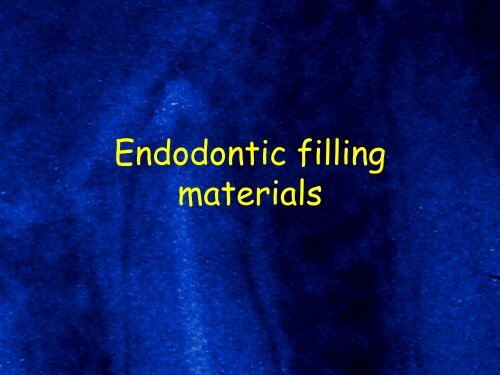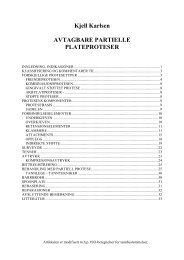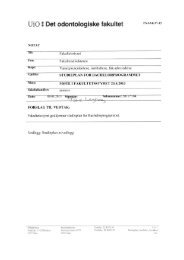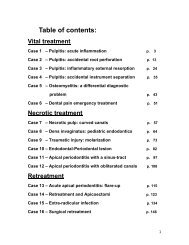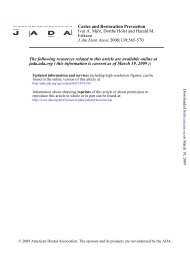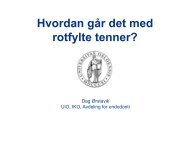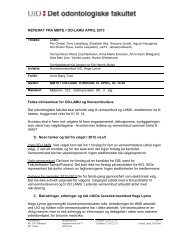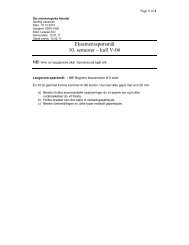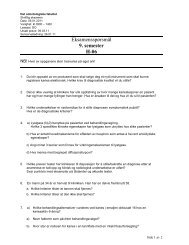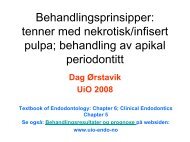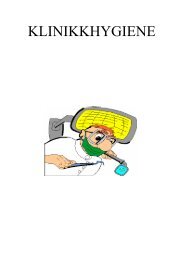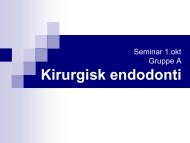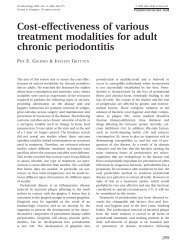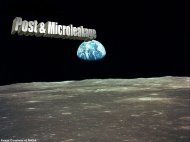Root canal sealers
Root canal sealers
Root canal sealers
You also want an ePaper? Increase the reach of your titles
YUMPU automatically turns print PDFs into web optimized ePapers that Google loves.
Endodontic filling<br />
materials
<strong>Root</strong> filling materials<br />
1. Stop coronal leakage<br />
2. Entomb surviving microbes<br />
3. Block influx of water and nutrients<br />
1 2<br />
3<br />
from Sundqvist & Figdor, in ’Essential Endodontology’, 1998
Core Materials<br />
• Gutta-percha<br />
• Metal points<br />
• Plastics<br />
• Combinations
Thermoplasticized gutta-percha:<br />
’hot-warm-soft’<br />
injectable<br />
carriers
’alpha-phase’ versus ’beta-phase’<br />
Alpha-guttapercha is supposedly more fluid<br />
and soften at a lower temperature. Some<br />
sophisticated declarations describe a core<br />
of beta- under a surface of alpha-guttapercha.<br />
Beta phase is made when heated<br />
alpha phase is rapidly cooled to room<br />
temperature. There is little if any<br />
documentation that this distinction is of<br />
importance.
All gutta-percha filling<br />
techniques, including<br />
compaction and other<br />
methods of softening<br />
gutta-percha, always end<br />
up requiring a sealer.
A sealer is what should meet the<br />
hard and soft tissues; the gutta-<br />
percha is merely a piston
Gutta-percha<br />
- adaptability<br />
ZEUG<br />
- dimensionally stable<br />
Silicon<br />
- biocompatible<br />
Chloroform<br />
- adaptability<br />
Chloropercha<br />
- biocompatible<br />
N2 & Endométhasone<br />
- antibacterial<br />
Glassionomer<br />
- why not?<br />
Colophony<br />
- adhesion<br />
Ca(OH) 2<br />
- bio-active<br />
Epoxy<br />
- hardness and adhesion
Endodontic Sealers<br />
• ZnO-eugenol-based<br />
• ZnO-’non-eugenol’-based<br />
• Polymeric cements<br />
• Glass ionomers<br />
• Silicones<br />
• Solvent-based<br />
• Ca(OH) 2 pastes
ZnO-Eugenol-Based<br />
Endodontic Sealers<br />
• Rickert’s sealer ⇒ Kerr PCS<br />
• Grossman’s sealer ⇒ Roth’s,<br />
ProcoSol<br />
• Wach’s paste<br />
• Robin’s paste ⇒ N2, RC2B
ZnO-eugenol-<strong>sealers</strong><br />
•Pro’s<br />
– Used for a century<br />
– Clinical documentation<br />
–Goodseal<br />
• Con’s<br />
– Local toxicity<br />
– Allergen<br />
– Poor stability?
ZnO-’Non-Eugenol’-Based<br />
Endodontic Sealers<br />
• Several proprietary brands<br />
• Poor if any documentation
Glass Ionomer-Based<br />
Endodontic Sealers<br />
•Endion<br />
•Ketac-Endo
Glass-ionomer-<strong>sealers</strong><br />
• Pro’s<br />
– Biocompatible<br />
– Clinical documentation?<br />
• Con’s<br />
– Leakage<br />
–Shrinkage
Glass ionomer sealer<br />
Of 378 followed-up teeth, there<br />
was 78.3% success, 15.6%<br />
incomplete healing, and 6.1%<br />
failure.<br />
Friedman et al., 1995
Polymer-Based<br />
Endodontic Cements<br />
•AH series<br />
•Diaket<br />
• Poly(methyl-methacrylate)<br />
• Resorcinol-formaldehyde<br />
• Composite resins
Epoxy-resin-<strong>sealers</strong><br />
•Pro’s<br />
– More than 40 years<br />
–Clinical<br />
documentation<br />
–Stable<br />
•Con’s<br />
– Toxic when fresh<br />
– Allergen<br />
– Leakage?
RealSeal<br />
Why do we call it RealSeal? Because it is the endodontic filling material that<br />
provides a REAL seal. And Resilon, the primary component of RealSeal, has<br />
also been proven to be biocompatible, nontoxic and nonmutagenic.1 RealSeal<br />
is:<br />
•Leak-Resistant. Unlike gutta percha, RealSeal leaves no gap for leakage.<br />
Coronal and apical leakage are substantially reduced.<br />
•Strengthening. Gives the root significant toughness.<br />
•Technique-Compatible. Works with your current filling method.<br />
•Retreatable. With chloroform and/or heat. Like Grossman’s formula,<br />
retreatments are easy.<br />
•Radiopaque. Just like your current method of obturation, detection is not a<br />
problem.<br />
Company website
”EndoREZ is a UDMA resin-based, root<br />
<strong>canal</strong> sealer with hydrophilic properties that<br />
improve sealing ability even in <strong>canal</strong>s that are<br />
moist with water.This resin-based formula<br />
prevents EndoREZ from compromising<br />
bonding agents. In addition to its<br />
biocompatible, methacrylate formula,<br />
EndoREZ also offers the advantage of<br />
radiopacity. EndoREZ is as radiopaque as<br />
gutta percha, thus simplifying radiographic<br />
interpretation.”<br />
Ultradent, company website
EndoREZ Points<br />
”Resin Coated Gutta Percha Points<br />
EndoREZ Points are standard ISO-sized gutta percha<br />
points overlayed with a thin resin coating. The resin<br />
coating allows EndoREZ Points to bond chemincally<br />
with EndoREZ and other resin-based <strong>sealers</strong>.<br />
Historically, gutta percha has only maintained a<br />
weaker, chemical bond with <strong>canal</strong> <strong>sealers</strong>. EndoREZ<br />
Points are the first-ever gutta percha points to create a<br />
stronger, chemical bond by bonding gutta percha to<br />
EndoREZ.”<br />
Ultradent, company website
Endodontic Sealers<br />
with Ca(OH) 2<br />
•Sealapex<br />
•Apexit<br />
•CRCS
Ca(OH)2-based <strong>sealers</strong><br />
•Pro’s<br />
–20 years<br />
– Clinical documentation<br />
–Goodseal<br />
– Biocompatible<br />
• Con’s<br />
– Unstable?<br />
– Poor x-ray contrast<br />
– Low mechanical<br />
strength
Changes in pH at the dentin surface<br />
in roots obturated with<br />
calcium hydroxide pastes.<br />
12<br />
pH at midroot<br />
surface<br />
11<br />
10<br />
9<br />
8<br />
7<br />
Control<br />
Sealapex<br />
Apexit<br />
Sealer 26<br />
Ca(OH)2<br />
6<br />
0 3 7 14 21 28 45<br />
TIME, days<br />
Esberard RM, Carnes DL Jr, del Rio CE J Endod 1996 Aug;22(8):399-405
Silicone-Based<br />
Endodontic Sealers<br />
•Lee Endofil<br />
•RoekoSeal<br />
• Gutta-Flow
Silicon-based <strong>sealers</strong>
Silicon-based <strong>sealers</strong><br />
•Pro’s<br />
–Verygood<br />
documentation<br />
– Clinically tested<br />
– Biocompatible<br />
• Con’s<br />
– No effect on microbes?<br />
– Poor mechanical strength<br />
– Short history
Picture: M.J.<br />
Roggendorf<br />
Picture: M. J. Roggendorf
Solvent-Based<br />
Endodontic Sealers<br />
• Rosin-chloroform (Johnston-Callahan<br />
technique)<br />
• Chloropercha techniques<br />
• Kloroperka
Solvent-baserte <strong>sealers</strong><br />
• Pro’s<br />
– Biocompatible<br />
– Clinical documentation?<br />
• Con’s<br />
– Leakage<br />
–Shrinkage<br />
No brand shown:<br />
Not to be promoted?
Technological tests
a<br />
b<br />
c<br />
d<br />
e<br />
f
DIMENSIONAL CHANGE, %<br />
6<br />
4<br />
2<br />
0<br />
0 4 8 12 16 20 24 28 32 36 40 44 48<br />
TIME, weeks<br />
AH 26<br />
AH 26 SF<br />
AH Plus<br />
Fig 3a
DIMENSIONAL CHANGE, %<br />
8<br />
6<br />
4<br />
2<br />
0<br />
-2<br />
0 4 8 12 16 20 24 28 32 36 40 44 48<br />
TIME, weeks<br />
Grossman's<br />
Proco-Sol<br />
PCS<br />
Tubli-Seal<br />
Fig 3b
DIMENSIONAL CHANGE, %<br />
1<br />
0<br />
-1<br />
0 4 8 12 16 20 24 28 32 36 40 44 48<br />
TIME, weeks<br />
Roeko-Seal<br />
RS 4823wet<br />
RS 4823dry<br />
Fig 3c
DIMENSIONAL CHANGE, %<br />
1<br />
0,5<br />
0<br />
-0,5<br />
-1<br />
-1,5<br />
0 4 8 12 16 20 24 28 32 36 40 44 48<br />
TIME, weeks<br />
Apexit<br />
Apexit H2O<br />
Ketac-Endo<br />
Fig 3d
0<br />
Hoop stress -<br />
(tension)<br />
Radial stress -<br />
(pressure)<br />
1 mm<br />
3 mm
100<br />
Tangential stress [MPa]<br />
10<br />
1<br />
0,1<br />
0,01<br />
0,001<br />
Composite<br />
Elastomer<br />
0 0,2 0,4 0,6 0,8 1<br />
Linear expansion of material [%]
Physical properties of endodontic<br />
<strong>sealers</strong>: radio-opacity, working time,<br />
flow and compressive strength<br />
measurements<br />
Ayce Unverdi Eldeniz<br />
Guest Researcher, Scandinavian Institute of Dental<br />
Materials, Haslum, Norway<br />
Dag Ørstavik<br />
Oslo University, Faculty of Dentistry, Head of the<br />
Department of Endodontics, Oslo, and the Scandinavian<br />
Institute of Dental Materials, Haslum, Norway
<strong>Root</strong> <strong>canal</strong> <strong>sealers</strong> tested:<br />
AH Plus<br />
Component A<br />
Epoxy resin<br />
Calcium tungstate<br />
Zirconium oxide<br />
Aerosil<br />
Iron oxide<br />
Component B<br />
Adamantane amine<br />
N,N-Dibenzyl-5-oxanonane<br />
TCD-Diamine<br />
Calcium tungstate<br />
Zirconium oxide<br />
Aerosil<br />
Silicone oil
<strong>Root</strong> <strong>canal</strong> <strong>sealers</strong> tested:<br />
GuttaFlow<br />
Gutta-percha powder<br />
Polydimethylsiloxane<br />
Silicone oil<br />
Paraffin oil<br />
Hexachloroplatinic acid<br />
Zirconium oxide<br />
Nano-silver<br />
(preservative)
<strong>Root</strong> <strong>canal</strong> <strong>sealers</strong> tested:<br />
AcroSeal<br />
Calcium hydroxide<br />
DGEBA<br />
Radiopaque excipient<br />
Glycyrrhetic acid<br />
(enoxolone)<br />
Methenamine<br />
Radiopaque excipient
<strong>Root</strong> <strong>canal</strong> <strong>sealers</strong> tested:<br />
EndoRez<br />
30% Urethane dimethacrylate
<strong>Root</strong> <strong>canal</strong> <strong>sealers</strong> tested:<br />
Epiphany<br />
Dual-cure, urethane-based<br />
dental composite cement
12,0<br />
10,0<br />
8,0<br />
6,0<br />
4,0<br />
2,0<br />
0,0<br />
<strong>Root</strong> <strong>canal</strong> <strong>sealers</strong>’<br />
radiopacity<br />
Radiopacity (n=3)<br />
Endo-REZ<br />
Epiphany<br />
RC Sealer<br />
Roeko Seal<br />
Gutta Flow<br />
Apexit<br />
Acroseal<br />
AH Plus
<strong>Root</strong> <strong>canal</strong> <strong>sealers</strong>’ film<br />
thickness<br />
Film Thickness (n=15)<br />
50<br />
45<br />
40<br />
35<br />
30<br />
25<br />
20<br />
15<br />
10<br />
5<br />
0<br />
AH Plus<br />
Endo-REZ<br />
Epiphany<br />
RC Sealer<br />
Roeko Seal<br />
Gutta Flow<br />
Apexit<br />
Acroseal
<strong>Root</strong> <strong>canal</strong> <strong>sealers</strong>’ flow<br />
Flow (n=15)<br />
50<br />
45<br />
40<br />
35<br />
30<br />
25<br />
20<br />
15<br />
10<br />
5<br />
0<br />
AH Plus<br />
Endo-REZ<br />
Epiphany<br />
RC Sealer<br />
Roeko Seal<br />
Gutta Flow<br />
Apexit<br />
Acroseal
<strong>Root</strong> <strong>canal</strong> <strong>sealers</strong>’<br />
compressive strength<br />
Compressive strength (Mpa) by time (h)<br />
400<br />
350<br />
300<br />
250<br />
200<br />
150<br />
100<br />
50<br />
0<br />
0 50 100 150 200<br />
?<br />
AH Plus<br />
Endo-REZ<br />
Epiphany<br />
Apexit<br />
Acroseal
Smear layer removal<br />
• Opens tubules for<br />
medicament<br />
activity<br />
• Removes (infected)<br />
smear and<br />
substrate for<br />
microbial growth<br />
• Allows permeation<br />
of filling material<br />
• Shows little effect<br />
on adhesion of<br />
filling<br />
• Penetration by<br />
bacteria may be<br />
enhanced:<br />
– Between sessions<br />
– After filling
Gr.<br />
1,20<br />
1,00<br />
0,80<br />
0,60<br />
0,40<br />
0,20<br />
0,00<br />
Native<br />
Phosph. Acid<br />
Citric acid<br />
EDTA<br />
Gr.<br />
APX<br />
KE<br />
AH Plus<br />
RS+P<br />
RS<br />
APX<br />
KE<br />
RS<br />
RS+P<br />
AH Plus<br />
Saleh et al., 2001:<br />
Adhesion of<br />
root <strong>canal</strong> <strong>sealers</strong><br />
to pretreated dentin
Antimicrobial<br />
activity<br />
• Toxic chemicals<br />
– disinfectants<br />
– antiseptics<br />
• Antibiotics
Iodine-containing gutta-percha<br />
(Lone Star)
Current antimicrobial<br />
additions<br />
•Formaldehyde<br />
•Eugenol<br />
•Thymoliodide<br />
•Amines<br />
• Calcium hydroxide
Clinical biocompatibility<br />
• Local<br />
•Regional<br />
• Systemic<br />
Severity<br />
Frequency
PN Liston, RF Walters<br />
Foreign bodies in the maxillary antrum: A case report<br />
Australian Dental Journal 2002;47(4):344-346
14d<br />
AH-materials give a strong<br />
reaction after 14d, but show little<br />
effect on tissues after 3 months<br />
3 months<br />
14d
Sealapex: Induction of hard<br />
tissue formation<br />
7<br />
6<br />
5<br />
4<br />
3<br />
2<br />
1<br />
Closure<br />
Partial closure<br />
No closure<br />
Inflammation<br />
0<br />
Sealapex<br />
Kerr PCS<br />
Holland & de Sousa 1985
Periapical reactions to<br />
<strong>sealers</strong> in monkeys<br />
8<br />
7<br />
6<br />
5<br />
4<br />
3<br />
2<br />
1<br />
0<br />
Sealapex CRCS AH26<br />
None<br />
Mild to moderate<br />
Severe<br />
27 teeth in 3 monkeys, 8-14 months<br />
Tagger & Tagger 1985
Allergy<br />
• (Almost) All endo materials contain<br />
allergens<br />
• The exposure to sensitive tissues is<br />
extremely small<br />
• Exposure to skin, mucosal surfaces of<br />
patients and the skin of staff may<br />
deserve more attention
Mutagenicity - Carcinogenicity<br />
• Mutagenicity– the ability to cause<br />
changes in the genes of an individual<br />
• Carcinogenicity– the ability to cause<br />
cancer in an individual<br />
• 70-90% of mutagens are carcinogens<br />
and vice versa
In vitro model for coronal leakage<br />
Upper chamber<br />
with bacteria<br />
Sterilised, root<br />
filled root<br />
Barthel et al, 1999<br />
Wax seal<br />
Lower chamber, sterile<br />
medium<br />
Bacteria penetrating the root filling multiply in the clear<br />
medium of the lower chamber, making it turbid.
% Microbial leakage over 30 days<br />
100<br />
90<br />
80<br />
70<br />
60<br />
50<br />
40<br />
30<br />
20<br />
10<br />
0<br />
S. mutans<br />
E. faecalis<br />
S. mutans and<br />
E. faecalis<br />
% of microbial leakage<br />
V GP - Epiphany sealer<br />
L GP - Epiphany sealer<br />
V GP - AH26 sealer<br />
L GP - AH26 sealer<br />
V Resilon - Epiphany sealer<br />
L Resilon - Epiphany sealer<br />
V Resilon - Epiphany sealer<br />
L Resilon - Epiphany sealer<br />
Negative Control<br />
Positive Control - GP<br />
Positive Control - Resilon<br />
Groups<br />
Epiphany –<br />
’an appearance or manifestation especially of a divine being’
Bacterial leakage<br />
100<br />
80<br />
60<br />
40<br />
20<br />
0<br />
Leaking teeth, %<br />
•AH Plus<br />
•EndoRez<br />
•RC Sealer<br />
•Roeko-Seal<br />
•Ketac-Endo<br />
•Acroseal<br />
•Apexit<br />
•Gutta-Flow<br />
•Epiphany
Bacterial leakage<br />
• AH Plus 15/15<br />
• EndoRez 15/15<br />
• RC Sealer 15/15<br />
• Epiphany 4/15<br />
• Acroseal 9/15<br />
• Apexit 5/15<br />
• Roeko-Seal 5/15<br />
• Gutta-Flow 5/15<br />
• Ketac-Endo 14/15
Saleh et al. 2003<br />
5<br />
Mean Log CFU<br />
4<br />
3<br />
2<br />
1<br />
0<br />
-1<br />
CT KE RSP AP RS CH GS AH<br />
CT KE RSP AP RS CH GS AH<br />
Sealer<br />
(CT: control; KE: Ketac-Endo; RSP: RoekoSeal Automix + Primer; AP:<br />
Apexit; RS: RoekoSeal Automix; CH: Calcium Hydroxide; GS:<br />
Grossman’s sealer; AH: AH Plus)
Clinical/Radiographic Follow-<br />
•Pain<br />
Ups<br />
• Success-failure<br />
analyses<br />
• Disease – no disease<br />
•Sizeoflesion<br />
• Periapical index<br />
• Computer technology
Time-course of postoperative pain following<br />
root filling with either Roeko Seal or<br />
Grossman’s sealer. Average values<br />
6<br />
Relative pain intensity, %<br />
4<br />
2<br />
Roeko Seal<br />
Grossman<br />
0<br />
D1S D1Be D2Br D2L D2S D2Be D3Br D3L D3S D3Be<br />
Coefficient of variation: 118-400%
EndoREZ<br />
Am J Dent. 2004 Feb;17(1):19-22.<br />
Clinical and radiographic evaluation of a resin-based<br />
root <strong>canal</strong> sealer.<br />
Zmener O, Pameijer CH
Clinical Study – EndoRez<br />
100<br />
90<br />
80<br />
70<br />
60<br />
50<br />
40<br />
30<br />
20<br />
10<br />
0<br />
91,3 89,1<br />
92,2<br />
All teeth CAP NAP<br />
'Success'<br />
’Feasibility study’
Cumulative PAI Scores<br />
AH KP PS<br />
0 1 2 3 4<br />
0 1 2 3 4<br />
0 1 2 3 4<br />
TIME: 0 to 4 years
Clinical Evaluation<br />
•Prevention<br />
– failure: AP developing where none<br />
existed<br />
– AH26 vs ProcoSol (Grossman’s sealer) vs<br />
Kloroperka: Significantly poorer results<br />
for Kloroperka in one clinical study
Healing of apical periodontitis following<br />
root filling with 3 different <strong>sealers</strong><br />
PERIAPICAL STATUS, ridit<br />
0,5<br />
0,4<br />
0,3<br />
0,2<br />
0 1 2 3<br />
Total<br />
ProcoSol<br />
Sealapex<br />
CRCS<br />
TIME, years<br />
Range of s.e. of means: 0.02-0.07
Preoperative Healthy Periodontium:<br />
Effect of Sealer<br />
PERIAPICAL STATUS,<br />
ridit<br />
0,3<br />
0,2<br />
0,1<br />
0<br />
0 1 2 3<br />
TIME, years<br />
Total<br />
ProcoSol<br />
Sealapex<br />
CRCS<br />
Range of s.e. of means: 0.03-0.17
X-ray<br />
healing<br />
AP<br />
N<br />
AP<br />
N<br />
Digital<br />
change<br />
AP/N < 1 AP/N ≅ 1
Numbers are average gray values in the<br />
defined areas: 255=white; 0=black<br />
130<br />
130<br />
80<br />
115<br />
Digital<br />
change<br />
AP/N =0,62 AP/N 0,88
AP/N<br />
1,2<br />
Sound<br />
Diseased<br />
1<br />
0,8<br />
0,6<br />
0 4 8 12 16 20 24<br />
TIME, months
From Trope et al., 1998
Healing by AP/N Ratio<br />
PA Status, P/N ratio<br />
80<br />
60<br />
40<br />
0 5 10 15 20 25<br />
TIME, weeks<br />
PS<br />
SA
Healing by PAI Score<br />
PA Status, PAI ridit<br />
1<br />
0,8<br />
0,6<br />
0,4<br />
0 5 10 15 20 25<br />
TIME, weeks<br />
PS<br />
SA
Comparative clinical testing<br />
• ProcoSol, Grossman’s sealer:<br />
REFERENCE<br />
– AH26: as good or better<br />
– Sealapex: as good or better<br />
– CRCS: no worse<br />
– RoekoSeal no worse<br />
– Kloroperka poorer<br />
– Epiphany as good or better
Healed cases, per cent<br />
100<br />
Prospective study of factors related to<br />
healing of AP<br />
90<br />
80<br />
70<br />
60<br />
Preop<br />
AP<br />
No<br />
preop<br />
AP<br />
Warm<br />
vertical<br />
Cold<br />
lateral<br />
Cliinical variables<br />
Single<br />
root<br />
2+ roots<br />
Farzaneh et<br />
al.<br />
JOE April<br />
2003, OR 45<br />
The Toronto<br />
study:<br />
outcome of<br />
initial<br />
endodontic<br />
treatment -<br />
phase II
New methods for filling root <strong>canal</strong>s<br />
must be viewed with regard to<br />
their ability to aid in achieving the<br />
prevention of new or persistent<br />
apical periodontitis; the acid test<br />
being roots with preoperative<br />
apical periodontitis
’Predictable disinfection’: how<br />
much can we improve?<br />
• instrumentation 90/10* 95/20<br />
• irrigation 99/50 99,9/95<br />
• ‘medication’ 99,9/95 99.99/98<br />
• <strong>Root</strong> filling 100/100?
Predictable disinfection<br />
1. Complete physical and<br />
chemical disinfection in one<br />
session?<br />
(’Dauerantisepticum’, CHX?)<br />
2. Prevention of regrowth<br />
(antibacterial sealer?)<br />
3. Block influx of nutrients<br />
(improved seal?)<br />
AP<br />
P<br />
PDL
’Predictable disinfection’: can<br />
we improve?<br />
Standard methods<br />
Improvement?<br />
Microbes Canals Microbes Canals<br />
• instrumentation 90 10 95 50<br />
• irrigation 99 50 99,9 95<br />
• dressing 99,9 95 99.99 98<br />
• <strong>Root</strong> filling 100 100?<br />
Thank you for your attention!


